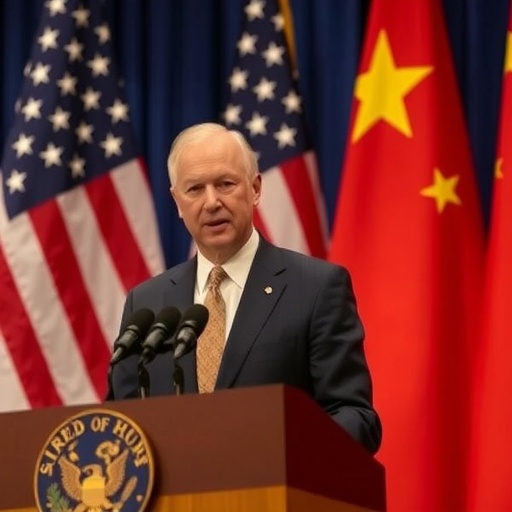US-China Trade Breakthrough: Treasury Secretary Scott Bessent Announces Tariff Framework to Aid Soybean Farmers and Ease Tensions
In a stunning development that could reshape global trade dynamics, Treasury Secretary Scott Bessent revealed on Wednesday that the United States and China have forged a substantial framework in their ongoing US-China tariff negotiations. This breakthrough, announced during a press conference in Washington D.C., promises to avert the imposition of hefty new tariffs and delay China’s planned export controls on critical rare earth minerals, offering immediate relief to American industries battered by years of trade friction.
The announcement comes at a pivotal moment, just weeks before a highly anticipated summit between President Donald Trump and Chinese President Xi Jinping. Bessent, a key architect of the administration’s economic policies, described the agreement as a “game-changer” that prioritizes mutual economic benefits while addressing long-standing grievances. “We’ve reached a framework that protects American workers and farmers without escalating into a full-blown trade war,” Bessent stated, emphasizing the deal’s potential to stabilize supply chains and boost exports.
For soybean farmers in the American heartland, who have endured devastating losses from previous tariffs, this news is nothing short of a lifeline. The framework includes provisions to ramp up Chinese purchases of U.S. agricultural products, particularly soybeans, which saw exports plummet by over 70% during the height of the 2018-2019 trade war. According to the U.S. Department of Agriculture (USDA), soybean exports to China totaled $12.3 billion in 2023, but punitive tariffs had previously slashed that figure by billions, forcing many farmers into bankruptcy or reliance on government subsidies.
Bessent highlighted the human element of the trade talks, noting, “This isn’t just about numbers on a balance sheet; it’s about families in Iowa and Illinois who can now look forward to fair markets.” The framework reportedly commits China to a phased increase in soybean imports, potentially restoring pre-trade war levels within the next fiscal year and injecting an estimated $5-7 billion back into rural economies.
Bessent’s Bold Move Reshapes US-China Tariff Landscape
Treasury Secretary Scott Bessent‘s revelation marks a significant pivot in the US-China relationship, which has been strained since the Trump administration’s initial tariff salvos in 2018. Back then, the U.S. imposed duties on $300 billion worth of Chinese goods, prompting retaliatory measures that hit American agriculture hardest. Fast-forward to today, and Bessent’s framework appears to de-escalate that cycle, focusing on targeted concessions rather than broad confrontation.
Details of the agreement, while not fully public, include a mutual suspension of proposed 25% tariffs on electronics and machinery, sectors vital to both economies. In exchange, the U.S. has agreed to ease restrictions on technology transfers, a sore point in previous rounds of trade talks. Economists at the Peterson Institute for International Economics estimate that full implementation could add 0.5% to U.S. GDP growth over the next two years by reducing import costs and enhancing export opportunities.
Bessent, who assumed the role earlier this year with a mandate to prioritize deal-making, credited intensive bilateral discussions held in Geneva last month. “Our negotiators worked around the clock to build trust,” he said. “This framework isn’t perfect, but it’s a foundation we can build on.” The secretary also alluded to safeguards against future violations, including dispute resolution mechanisms that could prevent the tit-for-tat escalations of the past.
Market reactions were swift and positive. The Dow Jones Industrial Average surged 2.1% following the announcement, with agricultural stocks leading the charge. Shares in Deere & Company, a major soybean equipment manufacturer, jumped 4.5%, reflecting investor optimism about renewed demand from China.
Soybean Farmers Hail Relief from Crushing Tariffs
Nowhere is the impact of this US-China breakthrough felt more acutely than among America’s soybean producers, who have been the unintended casualties of geopolitical maneuvering. In states like Illinois, Iowa, and Minnesota—where soybeans account for over 80% of farm output—the trade war inflicted wounds that lingered long after the initial headlines faded. A 2022 USDA report documented that farm bankruptcies rose 20% in the Midwest during peak tariff periods, with many operations teetering on the edge due to lost Chinese markets.
Take the case of Mark Thompson, a third-generation farmer from Ames, Iowa. “When China slapped those tariffs on our soybeans in 2018, it was like the ground opened up beneath us,” Thompson shared in an interview. “We lost half our income overnight. This framework? It’s a chance to get back on our feet.” Under the new deal, China pledges to purchase at least 25 million metric tons of U.S. soybeans annually for the next three years, up from the current 15 million tons—a volume that could stabilize prices and reduce the need for federal aid programs costing taxpayers $28 billion since 2018.
The framework also addresses logistical hurdles, such as port delays and certification standards that previously hampered exports. Industry groups like the American Soybean Association praised the move, with CEO John Heisdorffer stating, “This is a victory for free trade principles. Soybeans are the bridge that can mend US-China relations.” Beyond economics, the deal carries environmental undertones; increased U.S. exports could incentivize sustainable farming practices, as China demands greener supply chains amid its own carbon neutrality goals by 2060.
However, not all voices are unanimous. Some farmers worry about over-reliance on the Chinese market, which absorbs 60% of U.S. soybean output. Diversification efforts, including new deals with Brazil and the EU, will be crucial to mitigate risks if tensions resurface.
Rare Earth Delays Unlock Strategic Gains for U.S. Tech Sector
A lesser-discussed but equally vital component of the framework involves China’s decision to postpone export controls on rare earth minerals—elements essential for everything from smartphones to electric vehicle batteries. China dominates 80% of global rare earth production, and threats of restrictions had loomed as a leverage tool in trade talks. By delaying these controls for at least 18 months, Beijing has handed the U.S. a strategic reprieve, averting potential shortages that could have spiked prices by 50% or more.
Scott Bessent underscored the national security implications during his briefing: “Rare earths are the lifeblood of our innovation economy. This delay buys us time to diversify sources and invest in domestic mining.” The U.S. currently produces only 15% of its rare earth needs, relying heavily on Chinese imports valued at $160 million annually. The framework includes joint ventures for mining in Wyoming and Nevada, aiming to boost U.S. output to 25% by 2027.
Tech giants like Apple and Tesla, which consume vast quantities of these minerals, stand to benefit immensely. Analysts at Goldman Sachs project that stable supplies could shave 10-15% off battery costs, accelerating the green energy transition. One executive from a major semiconductor firm noted anonymously, “We’ve been on pins and needles. This US-China deal removes a massive uncertainty.”
Geopolitically, the concession signals China’s willingness to de-escalate amid its own economic challenges, including a slowing GDP growth rate of 4.7% in the latest quarter. By holding off on controls, Beijing avoids alienating Western buyers while maintaining leverage for future negotiations.
Trump-Xi Summit Looms as Catalyst for Lasting Trade Peace
As the dust settles on this framework, all eyes turn to the upcoming Trump-Xi summit scheduled for mid-November in Singapore. The meeting, originally framed as a high-stakes showdown, now holds promise as a ratification ceremony for the tariff accord. Diplomats on both sides have ramped up preparations, with agendas expanding to include intellectual property rights and currency manipulation—perennial flashpoints in US-China relations.
President Trump, known for his deal-making bravado, tweeted post-announcement: “Big win for America! Tariffs on hold, soybeans flowing—China knows we’re serious.” Xi, in a state media statement, echoed the sentiment: “Cooperation benefits all; confrontation harms all.” The summit could formalize the framework into a binding pact, potentially including enforcement teeth like WTO arbitration.
Experts anticipate ripple effects beyond bilateral ties. A stabilized US-China trade environment might encourage multinational firms to repatriate supply chains, creating 500,000 U.S. jobs in manufacturing and agriculture over the next decade, per a Brookings Institution study. For soybean farmers, sustained access to Chinese ports could mean record harvests; projections show U.S. production hitting 4.2 billion bushels in 2025 if tariffs remain paused.
Yet challenges persist. Hawkish voices in Congress decry the deal as too lenient, urging stricter oversight on Chinese subsidies. Environmental advocates push for green clauses in the final agreement. As Scott Bessent prepares to brief lawmakers, the path forward hinges on translating this framework into enduring policy.
Looking ahead, this breakthrough could herald a new era of pragmatic trade talks, where economic interdependence tempers rivalry. For American farmers, tech innovators, and consumers alike, the implications are profound: lower prices, job security, and a buffer against global disruptions. If the Trump-Xi summit delivers, the world might witness the thawing of the coldest trade war in decades, paving the way for collaborative solutions to shared challenges like climate change and supply chain resilience.







